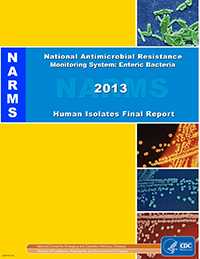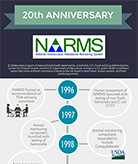About NARMS
Tracking Trends in Resistance
The National Antimicrobial Resistance Monitoring System – Enteric Bacteria (NARMS) is a US public health surveillance system that tracks antimicrobial resistance in foodborne and other enteric bacteria.
NARMS is an interagency partnership among the US Centers for Disease Control and Prevention (CDC), the US Food and Drug Administration (FDA), the US Department of Agriculture (USDA), and state and local health departments. Human surveillance began in fourteen sites in 1996 and became nationwide in 2003.
NARMS monitors antimicrobial resistance among enteric bacteria from three sources:
What kind of information does NARMS collect?
- Public health laboratories submit Salmonella, Campylobacter, Shigella, E. coli O157, and Vibrio (other than V. cholerae) isolates from clinical specimens from humans to CDC NARMS for antimicrobial susceptibility testing.
- Public health laboratories also submit isolates to CDC NARMS from Salmonella, Shigella, and E. coli outbreaks for antimicrobial susceptibility testing.
- Fourteen states participate in retail meat sampling. These states collect samples of chicken, ground turkey, ground beef, and pork chops each month to be cultured. Isolates of Salmonella, Campylobacter, Enterococcus, and E. coli are sent to FDA NARMS for serotyping, antimicrobial susceptibility testing, and genetic analysis.
- USDA NARMS conducts similar tests on isolates of Salmonella, Campylobacter, Enterococcus, and E. coli obtained from food-producing animal specimens at federally inspected slaughter and processing plants throughout the United States.
How does NARMS help investigators?

- Detects emerging trends of resistance;
- Links enteric illnesses (resistant and susceptible) to specific sources and risk factors;
- Understands the genetic mechanisms that confer resistance and its spread among enteric bacteria;
- Investigates enteric disease outbreaks;
- Educates consumers about foodborne antimicrobial resistance threats and food safety practices that protect against these threats;
- Guides public health priorities
- Provides information and recommendations that promote the judicious use of antimicrobial agents
Why is the information that NARMS collects important?
- Antimicrobial use in both humans and animals can lead to the development of antimicrobial resistant bacteria that cause human infections.
- Resistant bacteria can multiply and spread. They can also share their resistance with other kinds of bacteria to create new resistant bacterial strains.
- Most enteric infections are self-limiting, but antimicrobial agents are essential to treat severe illness. If pathogens are resistant to antimicrobial agents, illness may be prolonged or more severe.
- Measuring antimicrobial resistance in bacteria isolated from people, foods, and food animals is central to understanding and preventing transmission of antimicrobial resistant infections.
- Data provided by the NARMS program inform the development of public health interventions and policies designed to protect people from the threat of resistant enteric infections.
What kind of data and reports are published by NARMS?

- CDC NARMS publishes an annual report that includes a summary of antimicrobial susceptibility results for human clinical isolates tested by NARMS.
- Antibiotic resistance data from bacteria isolated from humans is available for download on NARMS Now: Human Data, an interactive tool from CDC.
- The annual Interagency NARMS Executive Report includes a summary of antimicrobial susceptibility results for human, retail meat, and food animal isolates in an integrated format.
- Annual summaries of antimicrobial susceptibility results for retail meat and food animal isolates tested by NARMS are available on the FDA NARMS website and the USDA NARMS website respectively.
- NARMS scientists publish additional scientific articles and reports describing the epidemiology and microbiology of antimicrobial resistance throughout the year, posted on the CDC NARMS, FDA NARMS, and USDA NARMS websites.
- Page last reviewed: August 19, 2015
- Page last updated: August 19, 2015
- Content source:



 ShareCompartir
ShareCompartir


